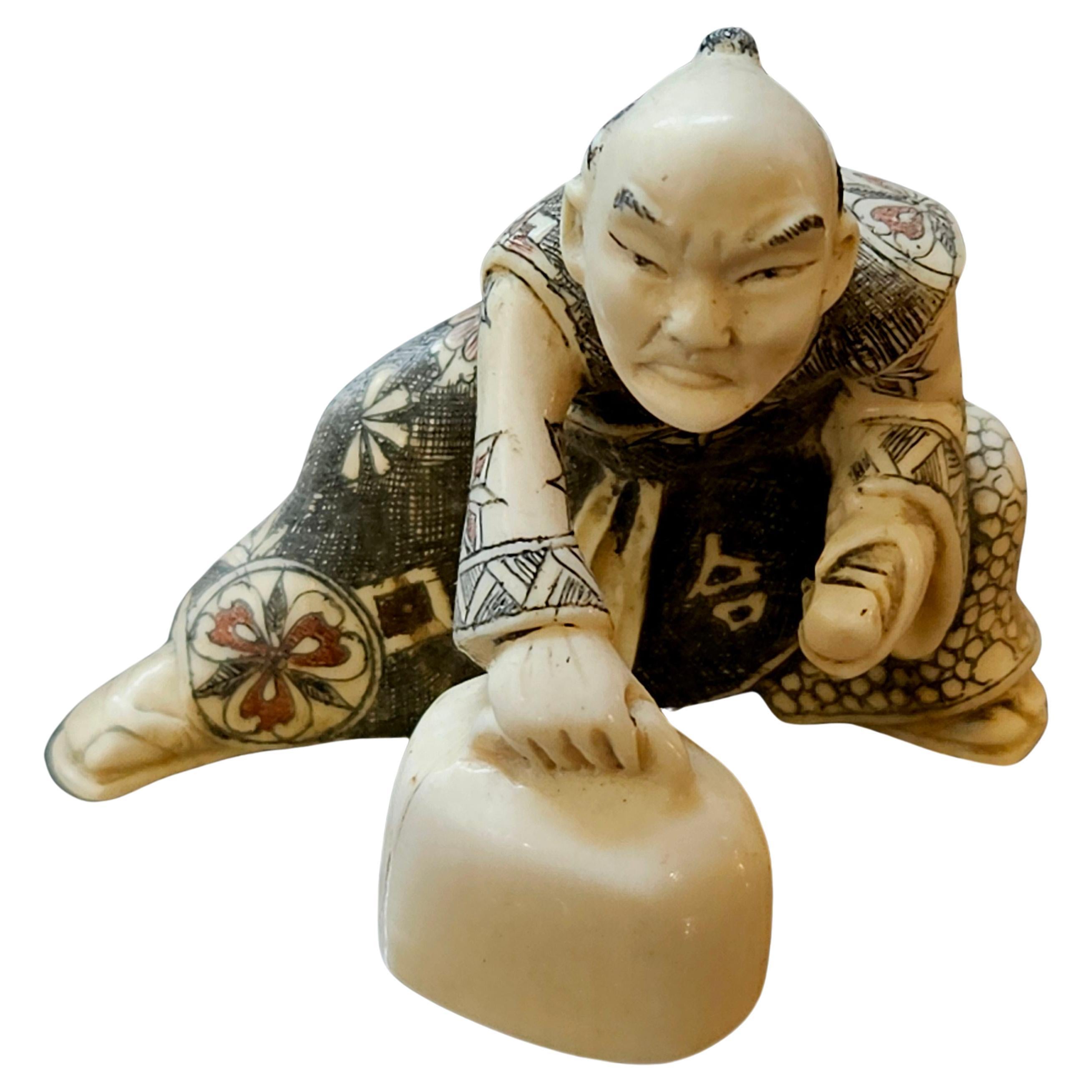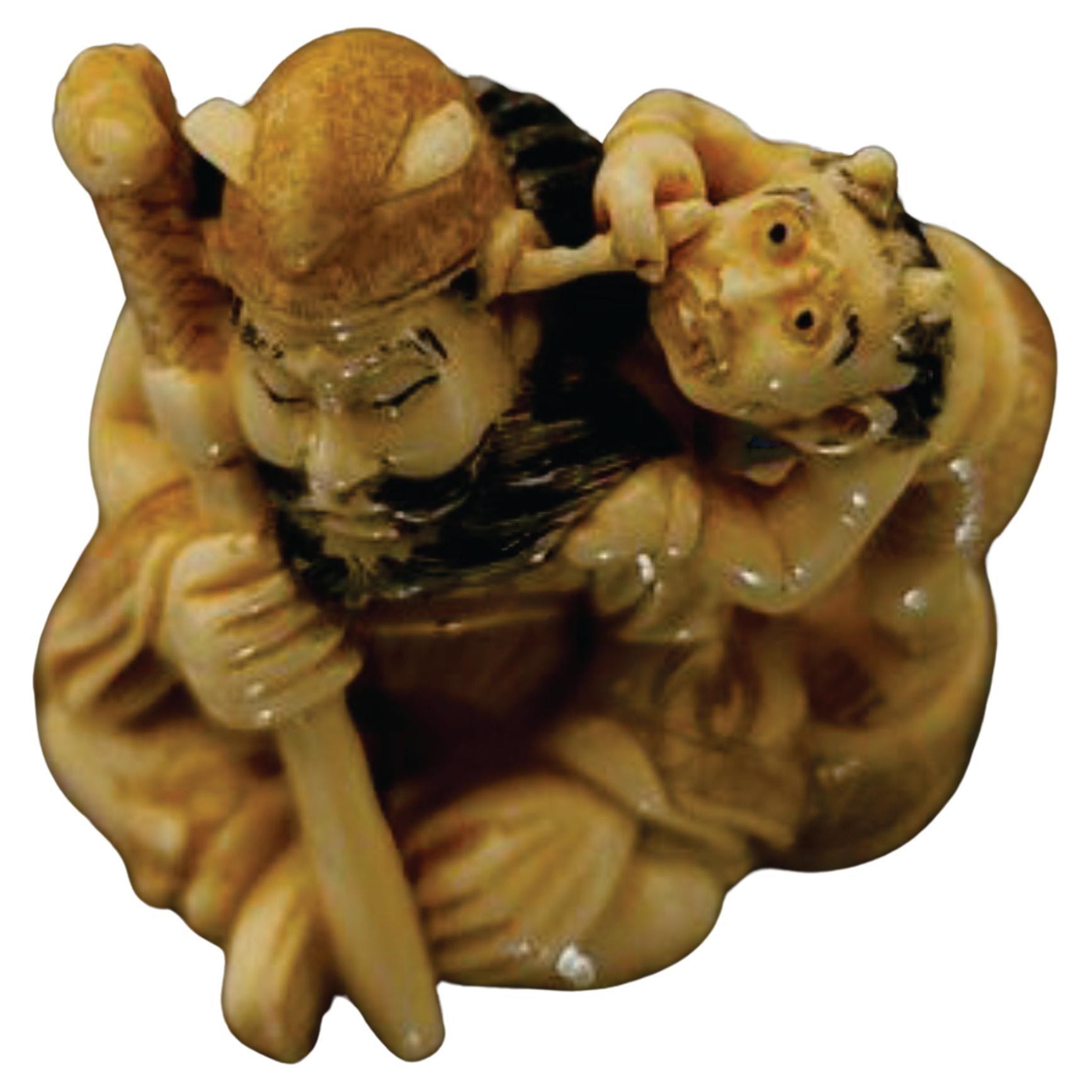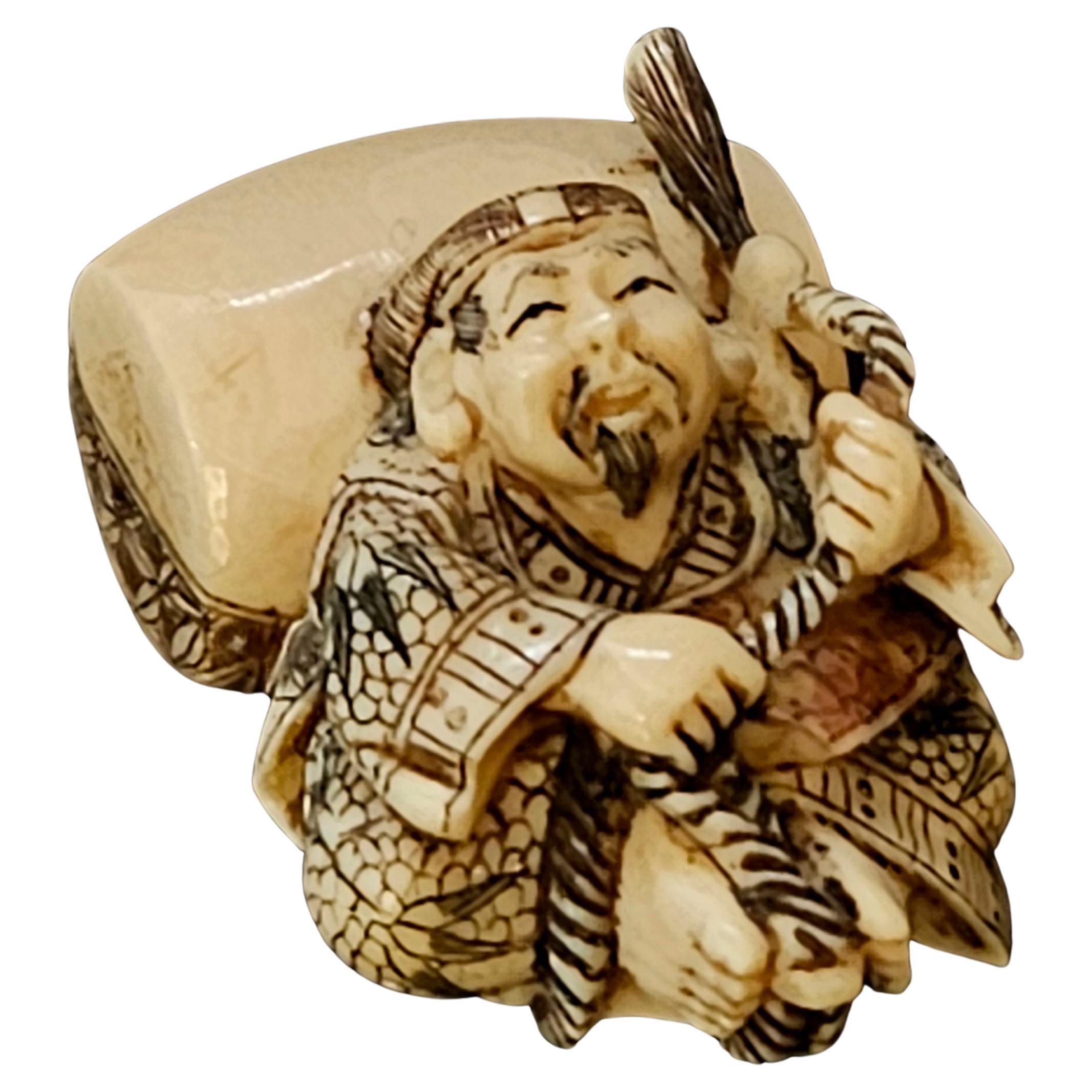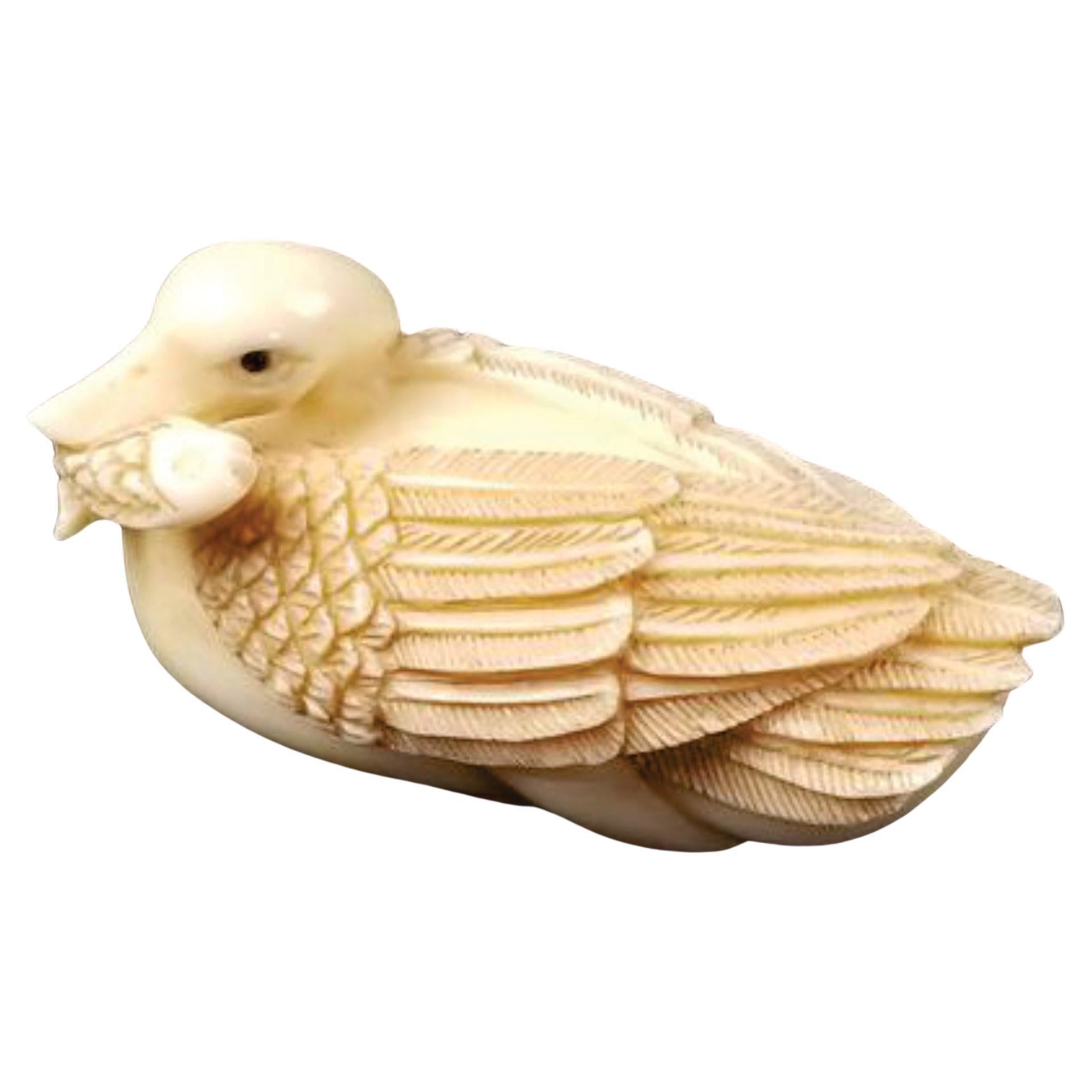Items Similar to Japanese Carved Netsuke Polychrome Decorated Figure, Signed by Yoshitomo, Meiji
Video Loading
Want more images or videos?
Request additional images or videos from the seller
1 of 13
Japanese Carved Netsuke Polychrome Decorated Figure, Signed by Yoshitomo, Meiji
About the Item
Netsuke Japanese Hand-Carved Polychrome Decorated Figure, Signed by Yoshitomo from the Meiji period. Ric.NA004
A truly hand-carved ivory figure, An old man holding a straw and soaking some sort of liquid from a container, shows a museum quality in detailing, signed by Matsuyoshi. A super excellent art in Japanese culture.
This item is 1.25" wide x1 .5" deep x 1.25" high in dimension, from the late 19th century, and has extremely fine carved art.
This item is in excellent condition with no damages.
The Essence of Netsuke:
Like all art objects of great worth, netsuke distills the essence of a specific time and place. Worn as part of a traditional Japanese man’s ensemble from the 17th century onwards, the netsuke’s purpose was hyper-specific, and its functional simplicity lent artists unlimited freedom to constantly redefine what it could be.
Formally, netsukes have few requirements: they must be small, they must have holes through which to pass a single cord, and they must have no protuberances that could damage one’s kimono. Everything else is left to the carver’s imagination. As such netsuke differs in style, subject, and material as widely as the personalities of their makers, and they are consequently supremely collectible.
Netsuke emerged as a practical solution to dressing in 17th-century Japan. ‘Men’s kimonos didn’t have sewn-up sleeves — they were completely open, front and back, and that meant that the sleeves couldn’t be used as a pocket, as they could in women’s kimonos,’ Goodall explains. To carry things such as tobacco, medicine, or other necessities, men hung stylish inro and other vessels from cords looped under and behind the wide sashes that held their kimonos in place. At the other end of those cords, men fastened small, ornamental objects as counterweights; those objects evolved into netsuke.
The netsuke’s origins are still ‘theoretical’, Goodall says. ‘It’s thought that, with increasing imports from China in the late 17th and early 18th centuries, the toggles that were used on Chinese clothing were imported,’ she explains. Those toggles may have spawned the netsuke.
But the netsuke we know today is a distinctly Japanese art form. ‘As the form developed, and as the netsuke carvers began to compete with each other to come up with new and different ways of handling netsuke, then it became a localized art form that did not relate to anything in China,’ Goodall says. ‘It had completed its evolution by the 19th century.’
Much like jewelry, watches, and handbags today, netsuke were worn to match different occasions and ensembles. Japanese men who could afford them amassed netsuke to diversify their wardrobes.
Still, as Japanese fashion became more influenced by the West, netsuke disappeared from everyday use. Westerners took up the collector’s mantle. ‘In the Meiji period, right after Japan opened to the West in 1854, Americans and Europeans discovered netsuke and immediately started collecting them,’ Goodall says. ‘Westerners were so intrigued by netsuke that carvers continued to make a living by selling them to Westerners.’
- Dimensions:Height: 1.25 in (3.18 cm)Width: 1.25 in (3.18 cm)Depth: 1.5 in (3.81 cm)
- Materials and Techniques:
- Place of Origin:
- Period:
- Date of Manufacture:19th Century
- Condition:Wear consistent with age and use. Wear consistent with age and use.
- Seller Location:Norton, MA
- Reference Number:1stDibs: LU5848239467522
About the Seller
5.0
Platinum Seller
These expertly vetted sellers are 1stDibs' most experienced sellers and are rated highest by our customers.
Established in 2000
1stDibs seller since 2021
85 sales on 1stDibs
Typical response time: <1 hour
- ShippingRetrieving quote...Ships From: Norton, MA
- Return PolicyA return for this item may be initiated within 3 days of delivery.
More From This SellerView All
- Japanese Carved Netsuke Polychrome Decorated Figure, Signed, Meiji PeriodLocated in Norton, MANetsuke Japanese Hand-Carved Polychrome Decorated Figure, Signed on the bottom from the Meiji period. A truly hand-carved ivory figure, A man is lifting a weight. It looks like he ...Category
Antique 19th Century Japanese Decorative Boxes
MaterialsIvory, Paint
- Japanese Carved Netsuke Polychrome Decorated Figure, by Shozan, MeijiLocated in Norton, MANetsuke Japanese Hand-Carved Mixed Material Figure, A Wise Man Holding a Treasure-Signed by Shozan from the Meiji period. Ric.NA006 A truly hand-carved ivory figure, A Wise Man Hold...Category
Antique 19th Century Japanese Decorative Boxes
MaterialsIvory, Paint
- Japanese Carved Netsuke Polychrome Decorated Figure Group by Tomoaki, MeijiLocated in Norton, MAJapanese Carved Netsuke Polychrome Decorated Figure Group, Signed by Tomoaki, Meiji period. Ric.NA005 A truly hand-carved ivory figure group, depicting a ghostbuster holding a sword...Category
Antique 19th Century Japanese Decorative Boxes
MaterialsIvory, Paint
- Japanese Carved Netsuke Polychrome Decorated Figur, Signed by Matsuyoshi, MeijiLocated in Norton, MANetsuke Japanese Hand-Carved Polychrome Decorated Figure, Signed by Matsuyoshi, from the Meiji period. Ric.NA003 A truly hand-carved mixed material figure, A Wise Man Holding a Rope,...Category
Antique 19th Century Japanese Decorative Boxes
MaterialsIvory, Paint
- Japanese Carved Netsuke A Goose Biting a Fish-Signed by Tomotada, MeijiLocated in Norton, MANetsuke Japanese Hand-Carved Mixed Material Figure, A Goose Biting a Fish-Signed by Tomotada from the Meiji period. Ric.NA007 This item is 2" wide x 1" deep x 0.75" high in dimensio...Category
Antique 19th Century Japanese Decorative Boxes
MaterialsIvory, Paint
- Antique Japanese Carved Okimono Polychrome Decorated Group by Gyokko MeijiLocated in Norton, MAAntique Japanese Carved Okimono Polychrome Decorated Figure Group seated on a wood stand, signed by Gyokko, depicting a seated artisan carving and decorating a figure of a happy Bud...Category
Antique 19th Century Japanese Decorative Boxes
MaterialsIvory, Paint
You May Also Like
- Box Wood Netsuke Turtle Mushroom Japanese Japan Signed, 20th CenturyLocated in Amsterdam, Noord HollandLovely and very detailed piece. Signed. Japan 19th or 20th century. Additional information: Material: Porcelain & Pottery Type: Incense Burners, Koro Region of Origin: Japan Period:...Category
20th Century Japanese Decorative Boxes
MaterialsPorcelain
- Japanese Meiji Period Silver Box Signed MasayukiLocated in Newark, EnglandJapanese Meiji period silver box with shibuichi plaque dating circa 1900. The box of rectangular form with a silver polished case stamped Jungin (J...Category
Antique Early 1900s Meiji Metalwork
MaterialsSilver
- Japanese Laquered Tray Decorated with People on a Verandah, Meiji PeriodLocated in Lincoln, LincolnshireThis is a good papier mâché, circular, black lacquered tray, hand enameled and gilded, made in Japan during the 19th century, Meiji period. This circular tray is very decorative, ...Category
Antique 19th Century Japanese Meiji Lacquer
MaterialsPaper
- Signed Japanese White Lacquer and Maki-E Lacquer Tansu, Meiji PeriodLocated in Ottawa, OntarioThe case decorated overall in crackle-glaze white lacquer and fitted with a patinated metal carrying handle over three tiers of small drawers. The first two tiers are comprised of a ...Category
Antique Late 19th Century Japanese Meiji Lacquer
MaterialsLacquer
- Japanese Cloisonne Box by Inaba, Meiji Period, circa 1900, JapanBy Inaba Cloisonne Co.Located in Austin, TXA fine Japanese cloisonne hinged box with pheasant and autumn foliage, by Inaba Nanaho and the Inaba Cloisonne Company, Meiji period, circa 1900, ...Category
Antique Early 1900s Japanese Meiji Metalwork
MaterialsCopper, Enamel, Metal
- Japanese Bronze and Mixed Metal Box, Signed To Base, Meiji PeriodLocated in Melbourne, VictoriaA rare Japanese Meiji period (1868 - 1912) circular bronze box and cover by Inoue, Kyoto, late 19th century. The cover embossed with gilt, silvered and coppered decoration of inse...Category
Antique Late 19th Century Japanese Metalwork
MaterialsBronze





